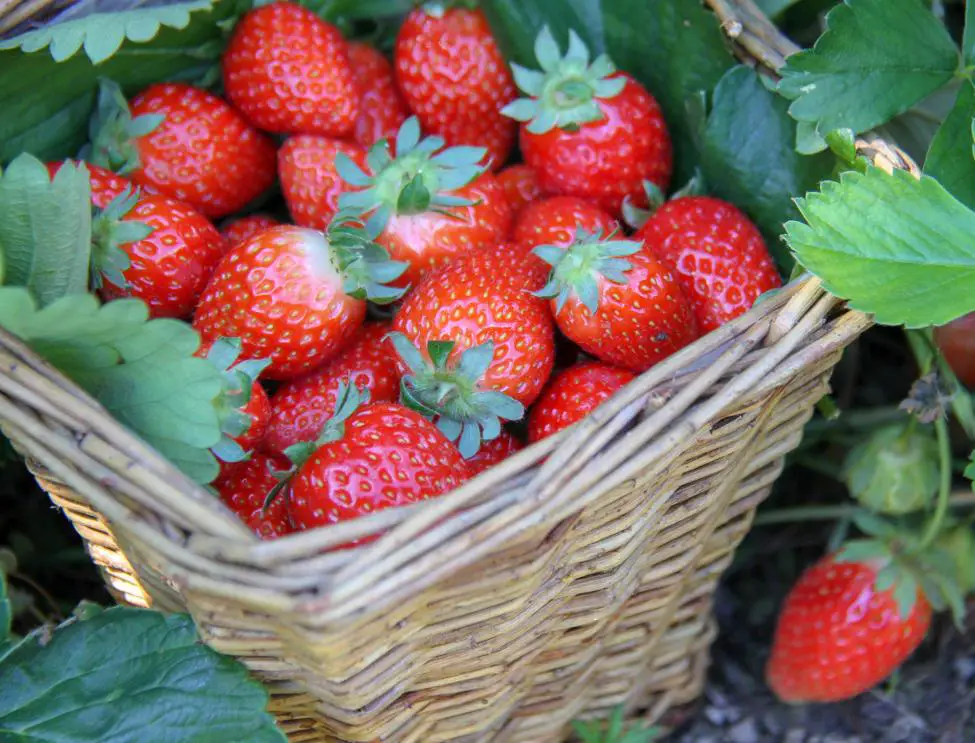The compact, trailing habit of strawberries makes them ideal for pots, containers or baskets. Also, since the fruits are off the ground, they are easier to look after and pick, and they are also less vulnerable to slugs and snails. If you grow a combination of different varieties, it is possible to have sweet, fresh strawberries from late spring right through autumn. Each variety has a short but heavy cropping period of two to three weeks. Perpetual strawberries, also known as ‘ever bearers’, are different: they produce small flushes of fruit continuously from early summer to early autumn.
Strawberry growing basics
Strawberries are well-suited to being cultivated in containers, but to achieve a successful crop you need to follow a few basic rules:
- Right planting season. Plant strawberries in late summer or early autumn so they have time to settle their roots before the cold weather sets in. You can also plant in early spring but you will not get a big crop that first year.
- Choose the right pot. Use any pot, hanging basket, window box, or even grow bag that is 10cm or deeper. Six plants will grow well in a basket 35cm wide, four or five in a grow bag, windowbox, or pot 20cm wide. Don’t be tempted to grow too many in one pot.
- When planting strawberries, make sure the crown is level with the soil surface. If strawberries are planted too deeply they rot, if too high they dry out and die.
- Fill each container with good-quality, multipurpose potting compost. Choose a humus-rich, moisture-retaining compost, and mix bonemeal and well-rotted manure before planting.
- Mulch with straw to conserve water and keep fruit clean and dry. Straw mulch placed around the ripening plants will keep them clean, and its light colour will raise the temperature around the fruit by reflecting the light.
- Feed regularly with a seaweed extract to ensure large and healthy fruits. You may have to net the fruits as they ripen to protect them from birds.
Some extra tips for growing strawberries
Harvesting and storage
- Covering plants with a fleece in early spring will encourage flowering, and so fruiting, a week earlier than normal. Remove the cover during the day to help visiting insects pollinate flowers. Bees love strawberry flowers and they will buzz around them, pollinating as they go.
- If growing on a windy site or you simply want to ensure a decent crop, pollinate flowers yourself with a small brush.
- Cut off runners, unless you want to propagate new plants, to keep energy focused on flower and fruit production.
- After cropping, remove all the old leaves, stems, and runners, as well as straw. Then feed plants with a balanced liquid fertilizer.
- Strawberries are easy plants to propagate, allow runners to root and then transplant into individual pots.
- In damp conditions, grey mould can be a big problem so always water from below and ensure good air circulation around plants.
- Fertile soil, pH 6-6.5 with plenty of organic matter is ideal, but do not plant strawberries where tomatoes, eggplants, potatoes or raspberries have been growing for at least 5 years. These crops can harbour Verticillium, a debilitating pathogen of strawberries.
Strawberries are ready for picking when they are luscious, and bright red all over. Harvest them at the warmest time of the day for sweet, fragrant fruit. Pick just before eating as strawberries do not keep well. Some varieties freeze well, and all can be made into jams.
Summer Strawberries
These berries crop in early to mid-summer and are considered the tastiest, most vigorous and highest yielding of all strawberries. After harvest, plants produce plentiful runners. To prevent overcrowding, which encourages disease and small berries, the bed needs to be renovated. Select and remove strong runners to plant back and replace older plants.
Ever-bearing Strawberries
These strawberries produce some berries in summer but more through autumn until cold conditions stop them. They are not considered the culinary equal of summer strawberries but are still vastly superior to anything available in the shops. Ever-bearers are smaller plants, they also require more nitrogen than others, so keep up with the blood and bone. Replace your ever-bearers every three years, as they do not respond well to renovation.
Strawberries are the symbol of lazy long summer days, fragrant and sweet. You can buy them in the shops, but why would you if you can grow something infinitely superior?
Note: Clicking the above links will take you to Amazon.com where you’ll get additional product information. If you make a purchase, we may earn a commission at no additional cost to you.

